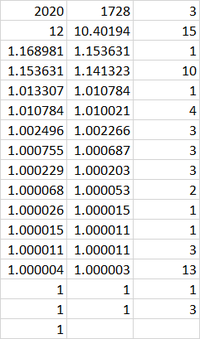Is there a neat way to solve this one?
Is there a neat way to round lo g 1 2 ( 2 0 2 0 ) to the nearest whole number?
The answer is 3.
This section requires Javascript.
You are seeing this because something didn't load right. We suggest you, (a) try
refreshing the page, (b) enabling javascript if it is disabled on your browser and,
finally, (c)
loading the
non-javascript version of this page
. We're sorry about the hassle.
4 solutions
We can easily calculate that 1 2 3 = 1 7 2 8 < 2 0 2 0 and 1 2 4 = 2 0 7 3 6 > 2 0 2 0 . So 4 lo g 1 2 > lo g 2 0 2 0 > 3 lo g 1 2 or 3 < lo g 1 2 2 0 2 0 < 4 . Hence ⌊ lo g 1 2 2 0 2 0 ⌋ = 3 . Since the difference between 2 0 2 0 and 2 0 7 3 6 is much larger than the difference between 2 0 2 0 and 1 7 2 8 , [ lo g 1 2 2 0 2 0 ] = 3 .
Thank you for sharing your solution.
It is only neat to know calculating logarithms with continued fractions . Not neat at all to do the computations. Let x = lo g 1 2 2 0 2 0 , then 2 0 2 0 = 1 2 x and we can express x as a continued fraction as follows:
x = n 0 + n 1 + n 2 + n 3 + ⋯ 1 1 1 1
And the n k are given by: 1 2 n 0 < 2 0 2 0 < 1 2 n 0 + 1 or n 0 = ⌊ lo g 1 2 2 0 2 0 ⌋ = 3 , n 1 = ⌊ lo g 1 2 3 2 0 2 0 1 2 ⌋ = 1 5 , n 2 = ⌊ lo g ( 1 2 3 2 0 2 0 ) 1 5 1 2 1 2 3 2 0 2 0 ⌋ = 1 ... As can be seen it is a very complicated way to calculate lo g 1 2 2 0 2 0 and I used an Microsoft Excel spreadsheet to implement the computations.

lo
g
1
2
(
2
0
2
0
)
can be written as a continued fraction as such, as you can see the result is equal to
3
after rounding.
Explanation please!
Log in to reply
I solved it using technology but I am still trying to find a good solution, the problem is original.
Refer to my solution.
Log in to reply
Thank you so much.
Log in to reply
@Hana Wehbi – May not be a good idea to set a problem you are unsure of the solution.
Log in to reply
@Chew-Seong Cheong – Actually, I did solve it using technology. It can be solved.
Log in to reply
@Hana Wehbi – But this type of algebra or number theory problems are not meant to be solved through software. It is not a computer science problem. I also checked the answer using Wolfram Alpha and know that it can be represented by continued fractions. The objective of using Brilliant to learn math and science is not just getting the answers for problems but learning how to solve the problems. Most of the problems can be solved by Wolfram Alpha, but what do the users learned? Just how to key in formulas into Wolfram Alpha and nothing else. There is no difference if you use Python, you are just learning coding and not math. The objective here is not just get the answer. That was why the member is asking you to explained. Because anyone who knows how to use Wolfram Alpha get the answer. But how the answer come about is math. From this problem I find that it is hopeless to use continued fraction to find logarithm. And thank you, otherwise I would not have known.
Log in to reply
@Chew-Seong Cheong – I honestly this is what I discovered too. In coding, you just need to memorize the right codes but there is no thinking involved. After learning coding and still learning, I am dedicating few time for Math because this is one is so important, it is the brain that is involved and not the machine.
Log in to reply
@Hana Wehbi – No, not just remembering the codes but how to use them. I learned Python because of Brilliant too. I am level 5 in computer science too. You can try on the problems many can be solved with Python. Just remembering codes won't do it is more complicated than that.
Log in to reply
@Chew-Seong Cheong – I see, l am still on the beginning but anxious to learn more. I am on level 3 with computer science, but l am not gonna give up. This is the only science field that l have no previous knowledge about.
1728=12^3<2020<12^(3,5)=3456*sqrt(3), hence 3<log_12(2020)<3,5. So the answer is 3.